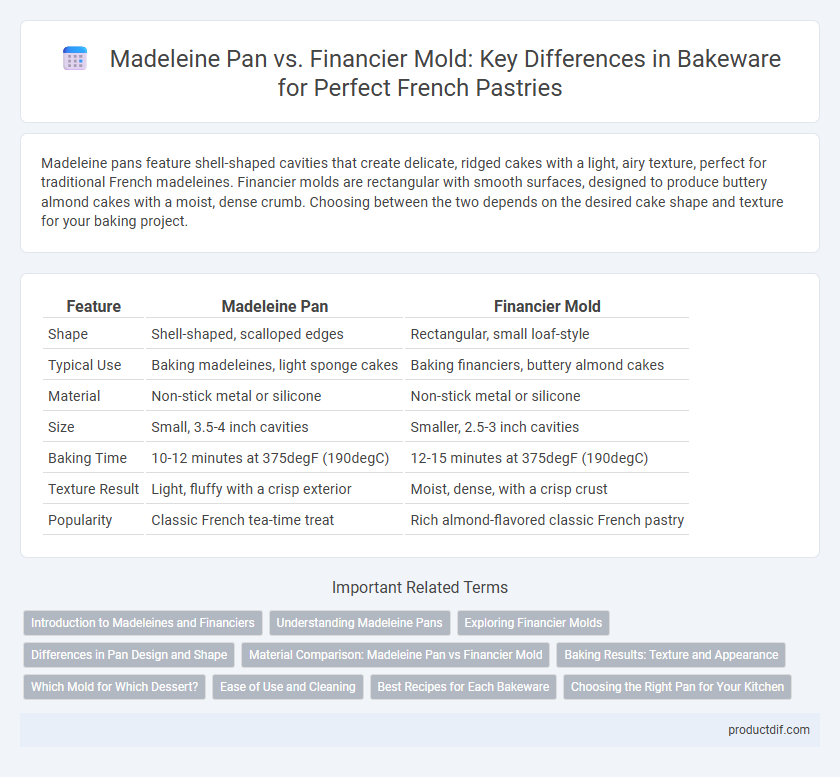Madeleine pans feature shell-shaped cavities that create delicate, ridged cakes with a light, airy texture, perfect for traditional French madeleines. Financier molds are rectangular with smooth surfaces, designed to produce buttery almond cakes with a moist, dense crumb. Choosing between the two depends on the desired cake shape and texture for your baking project.
Table of Comparison
| Feature | Madeleine Pan | Financier Mold |
|---|---|---|
| Shape | Shell-shaped, scalloped edges | Rectangular, small loaf-style |
| Typical Use | Baking madeleines, light sponge cakes | Baking financiers, buttery almond cakes |
| Material | Non-stick metal or silicone | Non-stick metal or silicone |
| Size | Small, 3.5-4 inch cavities | Smaller, 2.5-3 inch cavities |
| Baking Time | 10-12 minutes at 375degF (190degC) | 12-15 minutes at 375degF (190degC) |
| Texture Result | Light, fluffy with a crisp exterior | Moist, dense, with a crisp crust |
| Popularity | Classic French tea-time treat | Rich almond-flavored classic French pastry |
Introduction to Madeleines and Financiers
Madeleines are traditional French shell-shaped cakes known for their light, airy texture, typically baked in Madeleine pans designed with distinctive scalloped patterns. Financiers, small almond-based cakes with a moist, buttery interior, are baked in rectangular or oval financier molds that ensure even browning and a crisp crust. Both molds are essential in French patisserie, optimizing heat distribution to enhance the unique texture and flavor profiles of these classic confections.
Understanding Madeleine Pans
Madeleine pans feature shell-shaped cavities that create the signature scalloped edges essential for authentic madeleine cookies, while financier molds typically have rectangular or oval shapes designed for dense almond cakes. Understanding Madeleine pans involves recognizing their shallow depth and non-stick surface, which promotes even browning and the characteristic light, airy texture of madeleines. These pans are usually made from materials like aluminum or steel to ensure rapid heat conduction, critical for achieving the perfect rise and crisp exterior.
Exploring Financier Molds
Financier molds, traditionally crafted from copper or aluminum, provide superior heat conduction that ensures even baking and a desirable golden crust on the small almond cakes. Compared to Madeleine pans, financier molds come in rectangular shapes that enhance the batter's caramelization and create a distinct moist texture inside. Their varied sizes and material options offer versatility, making them essential for bakers aiming to master classic French pastries with optimal crumb structure and flavor.
Differences in Pan Design and Shape
Madeleine pans feature shell-shaped cavities with scalloped edges, designed to create light, airy sponge cakes with a distinctive hump, while financier molds are typically rectangular with straight edges to produce small, dense almond cakes. The material and depth of the pans also differ; madeleine pans are shallower with a concave shape that promotes even browning and a delicate crust, whereas financier molds are deeper to accommodate a moist, buttery interior. These design differences directly influence the texture, appearance, and baking time of the finished pastries.
Material Comparison: Madeleine Pan vs Financier Mold
Madeleine pans are typically made from aluminum or non-stick coated steel, offering excellent heat conduction for evenly baked, crisp-edged shells. Financier molds are often cast in copper or heavy-duty aluminum, providing superior thermal conductivity and precise temperature control essential for the dense, moist texture of financiers. Both materials contribute to distinct baking results, with aluminum favored for speed and non-stick properties, while copper excels in heat responsiveness and browning quality.
Baking Results: Texture and Appearance
Madeleine pans produce shell-shaped cakes with a crisp, golden exterior and a tender, buttery crumb, ideal for delicate, light textures. Financier molds yield small, rectangular cakes with a moist, dense texture and a rich, almond flavor, creating a smooth, glossy surface often enhanced by browning. Both molds impact the texture and appearance significantly, with madeleines showcasing a classic hump and financiers offering a uniform, slightly caramelized crust.
Which Mold for Which Dessert?
Madeleine pans feature shell-shaped cavities ideal for creating delicate, buttery Madeleines with their signature hump and soft crumb, while financier molds typically have rectangular or oval shapes designed to produce moist, almond-flavored French cakes with a tender texture. Choosing a madeleine pan enhances the crisp edges and light, airy structure of Madeleines, making it perfect for tea-time treats, whereas financier molds excel at delivering rich, nutty desserts with a crisp exterior and moist interior suited for sophisticated pastries. Selecting the appropriate mold ensures the dessert's texture, shape, and presentation match traditional standards and baking expectations.
Ease of Use and Cleaning
Madeleine pans feature shell-shaped cavities that allow for quick batter distribution and easy unmolding, making them highly user-friendly for beginners. Financier molds typically have rectangular or oval indentations that require greasing for easy release, which adds a step in cleaning and preparation. Both molds are generally made from non-stick materials, but madeleine pans often offer more straightforward cleaning due to their simpler shape and fewer corners where residue can accumulate.
Best Recipes for Each Bakeware
Madeleine pans excel in creating delicate, shell-shaped cakes with a light, buttery texture, ideal for classic Madeleine recipes featuring lemon zest and honey glaze. Financier molds produce rich, moist almond cakes with a crisp exterior, perfect for recipes that highlight browned butter and almond flour. Choosing the appropriate bakeware enhances the texture and flavor nuances specific to each French pastry tradition.
Choosing the Right Pan for Your Kitchen
Madeleine pans typically feature shell-shaped cavities that create delicate, scalloped cakes with a light, airy texture, ideal for traditional French madeleines. Financier molds, often rectangular with rounded edges, produce buttery, almond-flavored cakes with a denser crumb, perfect for particle-rich desserts. Selecting the right pan depends on the desired cake shape and texture, with madeleine pans suited for crisp edges and financier molds favored for moist, rich bites.
Madeleine Pan vs Financier Mold Infographic

 productdif.com
productdif.com